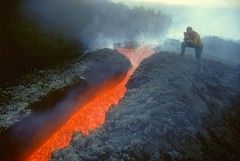On the morning of 7 September 2004, a small crack opened at the eastern base of the Southeast Crater cone and lava began to ooze out, forming a tiny flow just a few hundred meters long before the activity tapered out, a few hours later.
Three days later, on 10 September 2004, the new eruption started in earnest - a new vent opened at about 2600 m elevation, releasing a more substantial lava flow that cascaded down the steep western face of the Valle del Bove. This eruption was peculiar because there was almost no explosive activity, and the emitted lava seemed somewhat "old" - it was coolar and more crystalline than "normal" lava flows at Etna. To make things more serious, the start of this eruption was neither preceded nor accompanied by any noticeable seismic activity, so it came as a total surprise. Luckily it occurred far away from populated areas and cultivated land.
Still, it was a rather large eruption - it lasted six months, until 8 March 2005, and it emitted some 60 million cubic meters of lava, more than the previous eruptions of 2001 and 2002-2003. And it was beautiful, especially so during its first few weeks when weather conditions permitted easy access to the vent and we were frequently there.
This photo was taken during a visit to the active lava flow made with my friend Pippo Scarpinati sometime in late September 2004. At that time, my old Canon AE1 - with which I took this photograph - showed signs of aging, and the my lens had suffered from being too often in dense, acid volcanic gas plumes. Soon I would finally shift from slides and film to digital photography, a step many of my friends and colleagues had done much earlier.
:)
superrrrrrrrrrrrrr............
This it's the place for fun and fancy hobbies!!
A bunch of endless hobbies we can talk about!!!
If u have any sugestions or construtive comments, they are welcome!!
>:-)
All spam will be right away deleted and senders will be blocked!!
Thanks.
If u have any sugestions or construtive comments, they are welcome!!
>:-)
All spam will be right away deleted and senders will be blocked!!
Thanks.
tHe bloGs wE folloW
- Ahamed Z., MaldiVeS isLandS
- Alma Shánchez, SpaiN
- Bruno Nogueira, Twitter
- Bruno Nogueira,PorTugaL
- Everything Everywhere, Egypt
- Firefly, FlicKr, USA
- FunkNjaZZy, FlicKr
- FunkNjaZZy, Twitter
- Global Earthquakes
- Lia P., ReuNion IsLand
- Lisa Q., Usa
- Manu World News
- Manu World
- Manu World Fantasy
- Manu World in PanOraMio
- Manu World Music
- Mas k'é ixtu?!
- Ocean oF dreaMs, IperniTy
- Pedro Ribeiro,PorTugaL
- Penpals & Swappers Corner
- Special G., PhiliPPineS
FunKnJaZZy aT D'a TwiTTer
sTop **
sTop ** Pára-lá-com-issu-pahh!!!
**Stop SenDinG mE spaM via coMMenTs!!...doN't lOse uR tiMe!! I woN't LoSe miNe!! >:D
**Perontuzzzz,já activei aki uma treta q vos obriga a estarem registados p me mandarem essas merdas de SEX PICS,NUDE PICS,PARIS HILTON e o caraças!!! (A Paris está gasta, há k inovar,pah!) N KERO SABER DESSAS MERDAS AKI NO MEU ESTAMINÉ,ok? gajuzbuédamelgas!!! ide-á-bossa-bida...ide!! ide!!
Endless interesting
Endless fancy
Endless Music
- Anita Baker
- Chris Botti
- David Sanborn
- Freddie Jackson
- Gregg Karukas
- Ivan Lins
- Ivan Lins blog
- Jacksons Five
- Janet Jackson
- Jazz
- Jonathan Butler
- Lillo Thomas
- Lionel Ritchie
- Luther Vandross
- Marcus Miller
- Montreal Jazz Festival
- Pat Metheny
- S. O. S. Band
- Simple Minds
- Sky FM Radio station
- Smooth Jazz
- Smooth Jazz Concerts
- Steve Laury
oUr endleSS posTs
- December 2012 (8)
- November 2012 (17)
- October 2012 (22)
- September 2012 (22)
- August 2012 (14)
- July 2012 (21)
- June 2012 (33)
- May 2012 (39)
- April 2012 (27)
- March 2012 (22)
- February 2012 (22)
- January 2012 (26)
- December 2011 (22)
- November 2011 (12)
- October 2011 (12)
- September 2011 (8)
- August 2011 (16)
- July 2011 (13)
- June 2011 (13)
- May 2011 (10)
- April 2011 (17)
- March 2011 (16)
- February 2011 (24)
- January 2011 (38)
- December 2010 (23)
- November 2010 (9)
- October 2010 (6)
- September 2010 (13)
- August 2010 (17)
- July 2010 (29)
- June 2010 (17)
- May 2010 (18)
- April 2010 (12)
- March 2010 (25)
- February 2010 (24)
- January 2010 (11)
- December 2009 (8)
- November 2009 (13)
- October 2009 (8)
- September 2009 (9)
- August 2009 (14)
- July 2009 (4)
- June 2009 (11)
- May 2009 (16)
- April 2009 (25)
- March 2009 (72)
- February 2009 (18)
- January 2009 (4)
- December 2008 (2)
- November 2008 (4)
- October 2008 (4)
- September 2008 (3)
- August 2008 (6)
- July 2008 (4)
- June 2008 (6)
- May 2008 (5)
- April 2008 (7)
- March 2008 (6)
- February 2008 (2)
- January 2008 (6)
- December 2007 (21)
- November 2007 (32)
- October 2007 (1)
- May 2007 (1)
- April 2007 (4)
- March 2007 (5)
- February 2007 (12)

Custom Search
Followers
Policy
Website designed on Earth and available all over the Universe!! All texts & photos use are under Endless Hobbies Web Developper.



